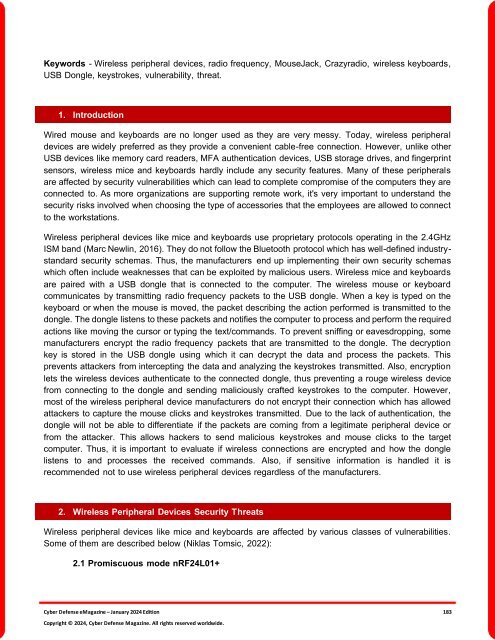The Cyber Defense eMagazine January Edition for 2024
Cyber Defense eMagazine January Edition for 2024 #CDM #CYBERDEFENSEMAG @CyberDefenseMag by @Miliefsky a world-renowned cyber security expert and the Publisher of Cyber Defense Magazine as part of the Cyber Defense Media Group as well as Yan Ross, Editor-in-Chief and many more writers, partners and supporters who make this an awesome publication! 201 page January Edition fully packed with some of our best content. Thank you all and to our readers! OSINT ROCKS! #CDM #CDMG #OSINT #CYBERSECURITY #INFOSEC #BEST #PRACTICES #TIPS #TECHNIQUES
Cyber Defense eMagazine January Edition for 2024 #CDM #CYBERDEFENSEMAG @CyberDefenseMag by @Miliefsky a world-renowned cyber security expert and the Publisher of Cyber Defense Magazine as part of the Cyber Defense Media Group as well as Yan Ross, Editor-in-Chief and many more writers, partners and supporters who make this an awesome publication! 201 page January Edition fully packed with some of our best content. Thank you all and to our readers! OSINT ROCKS! #CDM #CDMG #OSINT #CYBERSECURITY #INFOSEC #BEST #PRACTICES #TIPS #TECHNIQUES
Create successful ePaper yourself
Turn your PDF publications into a flip-book with our unique Google optimized e-Paper software.
Keywords - Wireless peripheral devices, radio frequency, MouseJack, Crazyradio, wireless keyboards,<br />
USB Dongle, keystrokes, vulnerability, threat.<br />
1. Introduction<br />
Wired mouse and keyboards are no longer used as they are very messy. Today, wireless peripheral<br />
devices are widely preferred as they provide a convenient cable-free connection. However, unlike other<br />
USB devices like memory card readers, MFA authentication devices, USB storage drives, and fingerprint<br />
sensors, wireless mice and keyboards hardly include any security features. Many of these peripherals<br />
are affected by security vulnerabilities which can lead to complete compromise of the computers they are<br />
connected to. As more organizations are supporting remote work, it's very important to understand the<br />
security risks involved when choosing the type of accessories that the employees are allowed to connect<br />
to the workstations.<br />
Wireless peripheral devices like mice and keyboards use proprietary protocols operating in the 2.4GHz<br />
ISM band (Marc Newlin, 2016). <strong>The</strong>y do not follow the Bluetooth protocol which has well-defined industrystandard<br />
security schemas. Thus, the manufacturers end up implementing their own security schemas<br />
which often include weaknesses that can be exploited by malicious users. Wireless mice and keyboards<br />
are paired with a USB dongle that is connected to the computer. <strong>The</strong> wireless mouse or keyboard<br />
communicates by transmitting radio frequency packets to the USB dongle. When a key is typed on the<br />
keyboard or when the mouse is moved, the packet describing the action per<strong>for</strong>med is transmitted to the<br />
dongle. <strong>The</strong> dongle listens to these packets and notifies the computer to process and per<strong>for</strong>m the required<br />
actions like moving the cursor or typing the text/commands. To prevent sniffing or eavesdropping, some<br />
manufacturers encrypt the radio frequency packets that are transmitted to the dongle. <strong>The</strong> decryption<br />
key is stored in the USB dongle using which it can decrypt the data and process the packets. This<br />
prevents attackers from intercepting the data and analyzing the keystrokes transmitted. Also, encryption<br />
lets the wireless devices authenticate to the connected dongle, thus preventing a rouge wireless device<br />
from connecting to the dongle and sending maliciously crafted keystrokes to the computer. However,<br />
most of the wireless peripheral device manufacturers do not encrypt their connection which has allowed<br />
attackers to capture the mouse clicks and keystrokes transmitted. Due to the lack of authentication, the<br />
dongle will not be able to differentiate if the packets are coming from a legitimate peripheral device or<br />
from the attacker. This allows hackers to send malicious keystrokes and mouse clicks to the target<br />
computer. Thus, it is important to evaluate if wireless connections are encrypted and how the dongle<br />
listens to and processes the received commands. Also, if sensitive in<strong>for</strong>mation is handled it is<br />
recommended not to use wireless peripheral devices regardless of the manufacturers.<br />
2. Wireless Peripheral Devices Security Threats<br />
Wireless peripheral devices like mice and keyboards are affected by various classes of vulnerabilities.<br />
Some of them are described below (Niklas Tomsic, 2022):<br />
2.1 Promiscuous mode nRF24L01+<br />
<strong>Cyber</strong> <strong>Defense</strong> <strong>eMagazine</strong> – <strong>January</strong> <strong>2024</strong> <strong>Edition</strong> 183<br />
Copyright © <strong>2024</strong>, <strong>Cyber</strong> <strong>Defense</strong> Magazine. All rights reserved worldwide.

















